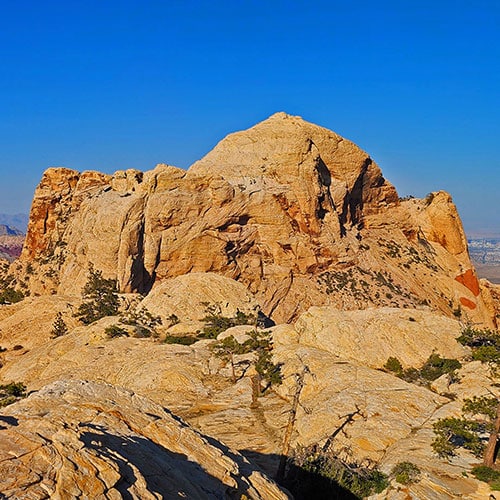The above map shows two potential starting points: From Willow Spring in Red Rock Canyon or from Lovell Canyon Road. If walking or extreme 4WD vehicle, start in Lovell Canyon. If good 4WD vehicle, start at Willow Spring.
The summit approach route drawing is approximate. Follow the cairns along the route for more detailed guidance. It’s strongly suggested you have a person with you who has summited Bridge Mt. previously if this is your first time!
New adventure slide guide to be posted Summer of 2024!
Many consider Bridge Mountain to be part of Red Rock Canyon National Conservation Area. This is because it is an obvious landmark seen from all points in Red Rock Canyon, and the main access route to Bridge Mountain is from the Willow Spring Picnic and Trailhead area of Red Rock Canyon. However, Bridge Mountain is actually in the Rainbow Mountain Wilderness, just below the Northern section of the Rainbow Mountains Upper Crest Ridgeline.
Bridge Mountain is one of the most popular destinations for hikers and rock climbers visiting of Red Rock Canyon. It offers a variety of challenges from class 3 to class 5 and beyond rock climbing.
The views from Bridge Mountain summit are spectacular, including Red Rock Canyon, the Las Vegas Valley and beyond, the Calico and Brownstone Basins and the the La Madre Mountains Ridgeline.
The best time of year to summit Bridge Mountain is during the Fall or Spring months. Summer temperatures can rise to around 100 degrees. Winter can bring ice and snow, turning the smooth ancient Jurassic Era frozen sand dunes that make up Bridge Mountain into treacherous slick icy surfaces with huge vertical exposures.
From I-215 take the Charleston Blvd exit (at Red Rock Casino) and head upward through Summerlin toward Red Rock Canyon National Conservation Area. Take the Red Rock Canyon scenic drive past the high point overlook to the Willow Spring picnic area between White Rock Mountain and the Rainbow Mountains that border the West side of Red Rock Canyon. Take Rocky Gap Road from Willow Spring picnic area. The summit area or Rocky Gap Road is about 5 miles from Willow Spring. There you will find the Bridge Mountain Trailhead. This is also the North Peak Trailhead.
This adventure route to Bridge Mountain begins at the intersection of Lovell Canyon Road and Rocky Gap Road in Lovell Canyon. If you’re heading to the Bridge Mountain trailhead on foot this is your shortest route.
Head up Rocky Gap Road to the Bridge Mountain Trailhead. If you’re on foot this is about a 2-mile stretch. If you’re driving, you’ll need a very rugged 4WD vehicle. There are portions of Rocky Gap Road that are entirely washed out and resembling a dry river gully wash complete with boulders both small and huge and slick dry falls! The Bridge Mountain Trailhead is located at the summit of Rocky Gap Road. Take a right onto the Bridge Mountain Trail and ascend to the summit of the Rainbow Mountains Upper Crest Ridgeline. A right turn on the ridgeline will put you on the Bridge Mountain Trail. In about a mile the trail circles around a long ridgeline and then descends that ridgeline to the base of Bridge Mountain. From the base of Bridge Mountain ascend the steep honeycomb sandstone ridge or alternate gully to the Bridge Mountain Arch. Ascend from the inner bowl of the arch to the tinajas and hidden forest area. Then, retrace this route back to the starting point.
Rocky Gap Road passes through the Wilson Ridge (the “gap” in “rocky gap”). You’ll see towering cliffs on either side and some opportunities to ascend to the summit of the Wilson Ridge and take the ridge either North all the way to Harris Mountain. A left turn at Harris Mountain would take you to Griffith Peak where you could descend the Sexton Ridge nearly all the way to the Lovell Canyon trailhead. About mid-way to Harris Mountain the La Madre Mountains Ridgeline splits off to the right and continues nearly all the way to the Las Vegas Valley. If you headed South on the Wilson Ridge you could take that ridge all the way to the lower opening of Lovell Canyon. You could also cross over to the Rainbow Mountains Upper Crest Ridgeline and take that ridgeline all the way to Highway 160 at the base of Potosi Mountain. So, the Wilson Ridge is a great connector ridge to Red Rock Canyon, the La Madre Mountains, the Rainbow Mountains and the Mt. Charleston Wilderness!
Today you’re heading up Rocky Gap Road to the Bridge Mountain Trailhead. In addition to the massive Wilson Ridge, notice a few great camping spots along Rocky Gap Road. Prepare to yield to a few fast moving ATVs on the road. You’ll hear then coming a long way off! The Bridge Mountain Trailhead is not very well marked, but it’s clearly the highest point on Rocky Gap Road. It’s on the right. There is a wide space for parking at the trailhead.
Ascend the Bridge Mountain Trailhead to its high point on the Rainbow Mountains Upper Crest Ridgeline. This is a limestone ridgeline that parallels the entire length of the Jurassic Era sandstone Rainbow Mountains. You can take the trail on the ridgeline in either a North or South direction and descend to each of the peaks in the Rainbow Mountains — they’re all connected by saddles descending from the ridgeline. Between the darker limestone of the ridgeline and the colorful sandstone on the Rainbow Mountains is the very distinctive dividing line of the famous Keystone Thrust Fault.
Today you’re taking a right on the ridgeline and in about a mile begin descending to Bridge Mountain, arguably the most famous and popular climbing destination in the Rainbow Mountains. As you traverse that first mile before descending toward Bridge Mountain take time to look around at the huge spectacular surroundings: Down to the Rainbow Mountains and to the Las Vegas Valley beyond; over to Red Rock Canyon and the La Madre Mountains Ridgeline; the Mt. Charleston Wilderness is to the Northwest; the line of Rocky Gap Road descends to Lovell Canyon. There’s much more, but the ridgeline is an amazing vantage point. The stretch of trail to Bridge Mountain is the most defined trail on the ridgeline. A very faint trail continues both North and South of the Ridgeline along the entire length of the Rainbow Mountains.
There’s a long descent ridge from the Upper Crest Ridgeline to the Western base of Bridge Mountain. The trail crosses over to the far (South) side of the descent ridge then begins its descent. Since you’re on the South side of the descent ridge, your most prominent view is of Rainbow Mountain, nearest peak to the South and Mt. Wilson behind Rainbow Mountain. You’re looking straight down into Pine Creek and Fern Canyons below. This is a good opportunity to plan an adventure in these canyons and up to Rainbow Mountain. You can see a lot of detail including Yoga Peak, a feature called UFO Rock and a caldera shaped like a boomerang. You can also see much of the climbing route from Pine Creek Canyon to the summit of Rainbow Wall. Some of these are pointed out in the video on this page.
As you reach the sandstone area above Bridge Mountain you’ll have a couple class 3 stretches to downclimb: A honeycomb formation and a narrow chute. None of these are major, but previous rock climbing experience or a partner with that experience will be valuable.
Your ascent route target is a couple tall cracks leading from the Western base of Bridge Mountain to the ledge with the arch. These distinctive features are located near the South (right) side of the Western base of the mountain. You’ll zig-zag up some large sandstone slabs with a 10-20% incline to get to the base of the first crack.
At the base of the first crack you have a choice. You can ascend the towering, exposed honeycomb class 3-4 ridge or the long crack to the left. The crack has much less exposure, but there are some ledges to ascend within the crack. The steep exposed honeycomb formation is…STEEP and EXPOSED, but I actually found it easier to ascend and descend than the crack because there were no lodges and the surface was very consistent with lots of hand and footholds. But the exposure was quite unnerving. During the ascent I just kept my eyes on my hands and feet, refraining from looking up or down of to the side! But, I’d never ascended something like this before. To loose your hold and fall during this stretch would most likely be a life-ending experience. However, note that on the return descent, though I started in the more protected crack, I soon moved back to the exposed ledge and actually descended facing outward, looking around and feeling more relaxed. However, I was still moving step by step with three solid points of contact at all times.
Once you’ve topped the first long crack/ridge, there’s a slight jog to your left and a SECOND long ridge or crack to ascend. The incline on this second stretch is a bit less which is very welcome at this point!
The above two stretches are the most challenging of the entire Bridge Mountain climb…even more so than the final summit approach.
At the summit of that second crack/ridge breathe a sigh of relief and take a few steps to your left on the wide ledge to the spectacular massive Bridge Mountain Arch. You want to look at this amazing feature from as many angles as possible. Looking from the outside in you’re looking through the arch into a large bowl. Upon entering the bowl and looking out many things are true at once: There are 3 tall steep sides; There is a distinctive echo; There’s an incredible framed view of the Mt. Charleston Wilderness through the arch; One of the sides of the bowl is near as steep and challenging as the exposed ridge/crack you just summited, but there are a lot of features to anchor your ascent/descent including a large fallen tree that actually serves as a great ladder during the descent.
Upon ascending out of the bowl you’re on a large sandstone slab looking down to your left (West) into a beautiful tinaja. Below to your East is the beautiful long Ponderosa Pine strand called the “Hidden Forest”. Above the Hidden Forest is the final summit approach zig-zagging up to the top of the large summit bulb. There are cairns to follow on the final summit approach…as there are cairns along most of the sandstone part of the route to Bridge Mountain. And the surrounding view is incredible! There’s the Las Vegas Valley and Strip below to the East, Red Rock Canyon, the Calico Basin and La Madre Mountains to the Northeast, the Rainbow Mountains stretching North and South, Rainbow Mountain and Mt. Wilson to the South and the Rainbow Mountains Upper Crest Ridgeline to the West, North Limestone Peak and North Sandstone Peak are to the North, and much much more. Big picture: You’re seeing sculpted sandstone settings, pine forested ridges, snow-capped mountains, desert valleys and a huge metropolitan area with a world-famous casino strip.
We did not have time for the final summit approach during this adventure, but I believe we experienced the best of Bridge Mountain.
~~~~~~~~~~~~~~~~
I initially made it to the final summit approach of Bridge Mountain. The route was up Rocky Gap Road from Willow Spring, then along the Rainbow Mts. Upper Crest Ridgeline on the North Peak Trail.
This exploration provided great view of Bridge Mountain from above on North Peak and the Rainbow Mountains Upper Crest Ridgeline
The Rainbow Mountains Upper Crest Ridgeline is about a mile up from the Bridge Mountain Trailhead. The trail is excellent. Once on the Rainbow Mountains Upper Crest Ridgeline, a left turn (North) will take you to North Peak in about 1/4th mile. Instead, turn right (South) for Bridge Mountain. As you continue on the ridgeline, Bridge Mountain soon comes into view. The Upper Crest Ridgeline will descend for a bit, then ascend to the next high point. At that high point, the Bridge Mountain Trail takes a left (East) and descends from the Upper Crest Ridgeline to the base of Bridge Mountain. Once you cross over onto the Jurassic Era frozen dune of Bridge Mountain there will be cairns to guide the way.
This was a descent to the base of Bridge Mountain in anticipation of a future ascent to the summit.



Return often to experience one new adventure each week! From the home page scroll to “Most Recent Adventures“. More about David Smith…
The trail adventures on this website require proper conditioning, preparation and safety precautions. There are many factors beyond our control including weather conditions, unstable ground, loose rocks, insects and snakes, people you may encounter, your own level of physical conditioning, the potential of getting lost just to mention a few. While this site offers guidance, helpful tips, direction and training, the reader assumes full responsibility for whatever may occur during their trail adventure. Have fun and be safe!